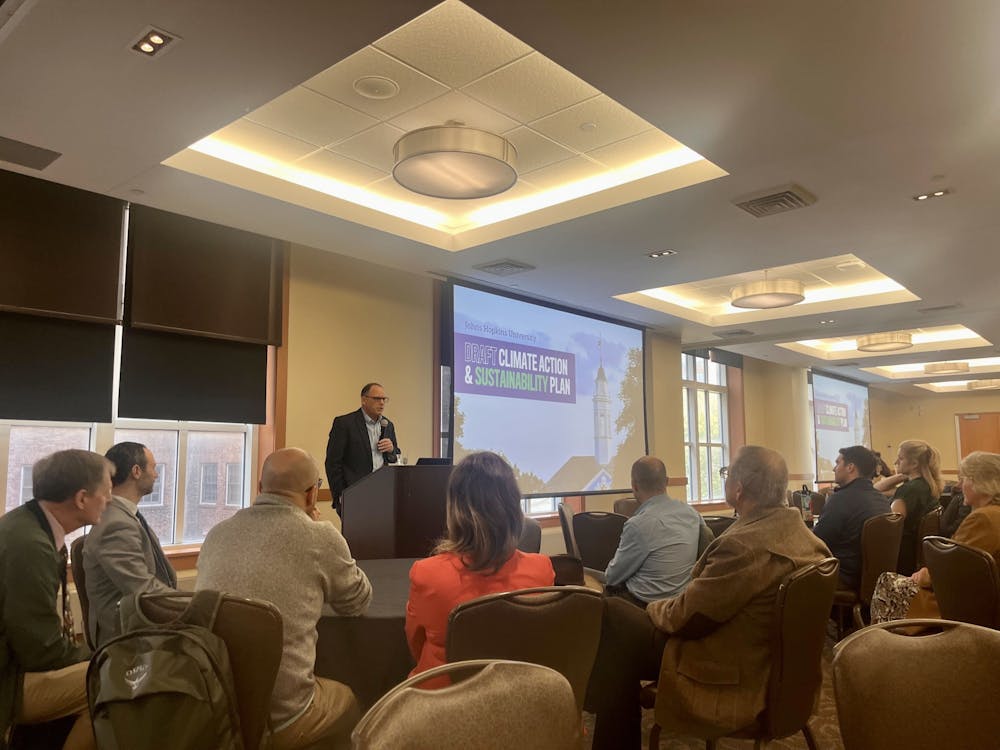Representatives from the Office of Sustainability and the Ralph O’Connor Sustainable Engineering Institute gathered with interested students on Oct. 13 to discuss the recently published Climate Action and Sustainability draft.
After introductory presentations, attendants were invited to provide feedback at individual stations showcasing a section of the plan by a presenter. The plan can also be found online where readers can make comments on the draft until Oct. 20.
Director of Sustainability in the Office of Sustainability Julian Goresko explained that student feedback is the central objective of the town hall.
“The purpose of this town hall is to share about our vision, the process through which we arrived at it, and so hear from you to give space for feedback and comments,” he said. “So we can really revise the top of the strongest version of this plan for the Johns Hopkins community.”
The proposal itself was developed collectively by the Sustainability Plan Steering Committee, three advisory groups, four technical working groups and other organizations. These groups make up a portion of the 1,500 students, faculty staff and community members who contributed or gave feedback to shape the plan.
In an interview with The News-Letter, Office of Sustainability Engagement Intern Simrin Carlsen expressed her excitement about the collaborative making of this plan.
“Really, I am just excited that it culminated in this. That we are giving such a voice to our students and faculty and all the stakeholders,” she said. “It’s not just something that is being imposed top-down but is really holistic and willing to hear from people who support and even don’t support all sides.”
The plan contains five sections. In an email to The News-Letter, Goresko explained that the plan leads with Research, Teaching and Scholarship, which emphasizes embedding climate and sustainability priorities into the University’s academics and operations to create broad-scale change.
“This includes objectives to infuse sustainability into the academic experience of all JHU students, expand sustainability internship programs, career advisement, and campus-based research opportunities,” he wrote.
The second part of the plan focuses on climate action, with a pledge for the University to reach net zero greenhouse gas emissions by 2040. While many student attendees admired this goal, others thought the goal seemed unrealistic.
Avro Justice explained his skepticism in an interview with The News-Letter.
“I'd be skeptical of [a target net zero emissions in 2040] just in general because it's such a common pledge,” he said. “And because unless they improve something with carbon capture, they’re always going to be using gas.”
The plan also includes a promise to cut down emissions by 51% by 2025, a goal that the University has already accomplished due to the renewable solar agreement.
The plan does not solely focus on emissions; section three of the proposal pledges to create eco-friendly infrastructure, introducing a green building standard that will be enforced across the institution. In addition, the section emphasizes adding and maintaining greenspace, ensuring biodiversity and protecting water resources.
Section four details how the University plans to ensure responsible consumption. One of the primary goals is to increase waste stream diversion, which includes recycling and source reduction, to 50% by 2030. The University also hopes to locally source 40% of the food in the Hopkins dining program and 35% of the food to meet Maryland’s sustainability standards.
The concluding section of the Climate Action and Sustainability Plan aims to implement greener transportation and mobility. The objectives emphasize integrating the University into the local Baltimore transportation system as well as purchasing electric vehicles for the University.
With an emphasis on developing a more sustainable culture across the University, cutting emissions and providing climate leadership amongst the Baltimore community, this new five-part plan is set to replace the previous 2009 Climate Change Implementation Plan.
Goresko explained that apart from the general betterment of the University, the plan will result in genuine changes in student life. He explained what students should expect to see as the key actions of the plan start to be implemented.
“The Plan’s section related to Responsible Consumption will have some of the biggest impacts on students’ day-to-day lives, including commitments to achieving zero waste priorities and increasing waste diversion to 50%, while further embedding sustainability in the food and dining experience,” he said. “We are excited to partner with students on the education and behavior change necessary to meet these priorities.”





